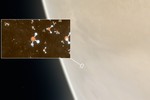Conducting science in space is never simple. Imagine trying to study a specific region of the Sun in painstaking detail, from 150 million kilometres away – with less than five minutes to do the job.
That’s the task that faced the CLASP project. CLASP is a high-tech telescope that was packed into a rocket and launched into space in 2015. This week scientists have finally finished their analysis of the pictures it took.
Once in space, CLASP was ejected from the rocket and had just 5-minutes to carry out unrivalled observations of the Sun from 150km above the Earth. It then used a parachute to land safely back on Earth.
Thanks to CLASP, scientists have been able to explore the magnetic field on the top layer of the Sun’s surface in detail for the first time ever!
It measured a very specific type of light that comes from this region of the Sun and is very sensitive to magnetic fields. By looking at how the light has been altered, they can work out how strong the magnetic field is and its direction.
But why bother studying the magnetic field? Well, not only does it play a crucial role in the shape of the Sun's surface layers, it acts as a channel for material and energy to flow out of the Sun. Some of it which heads toward us as powerful solar flares that can disrupt our satellites and affect astronauts on the International Space Station.
Better understanding how the Sun releases these bursts of energy will help us prepare against them!
Cool Fact
CLASP is what we call a ‘sounding rocket’. These are used to carry instruments between 50 and 1,500 kilometres above the Earth. Somewhere between weather balloons and satellites. The maximum height for balloons is about 40 kilometres, and the minimum for satellites is about 120 kilometres.
Share:














